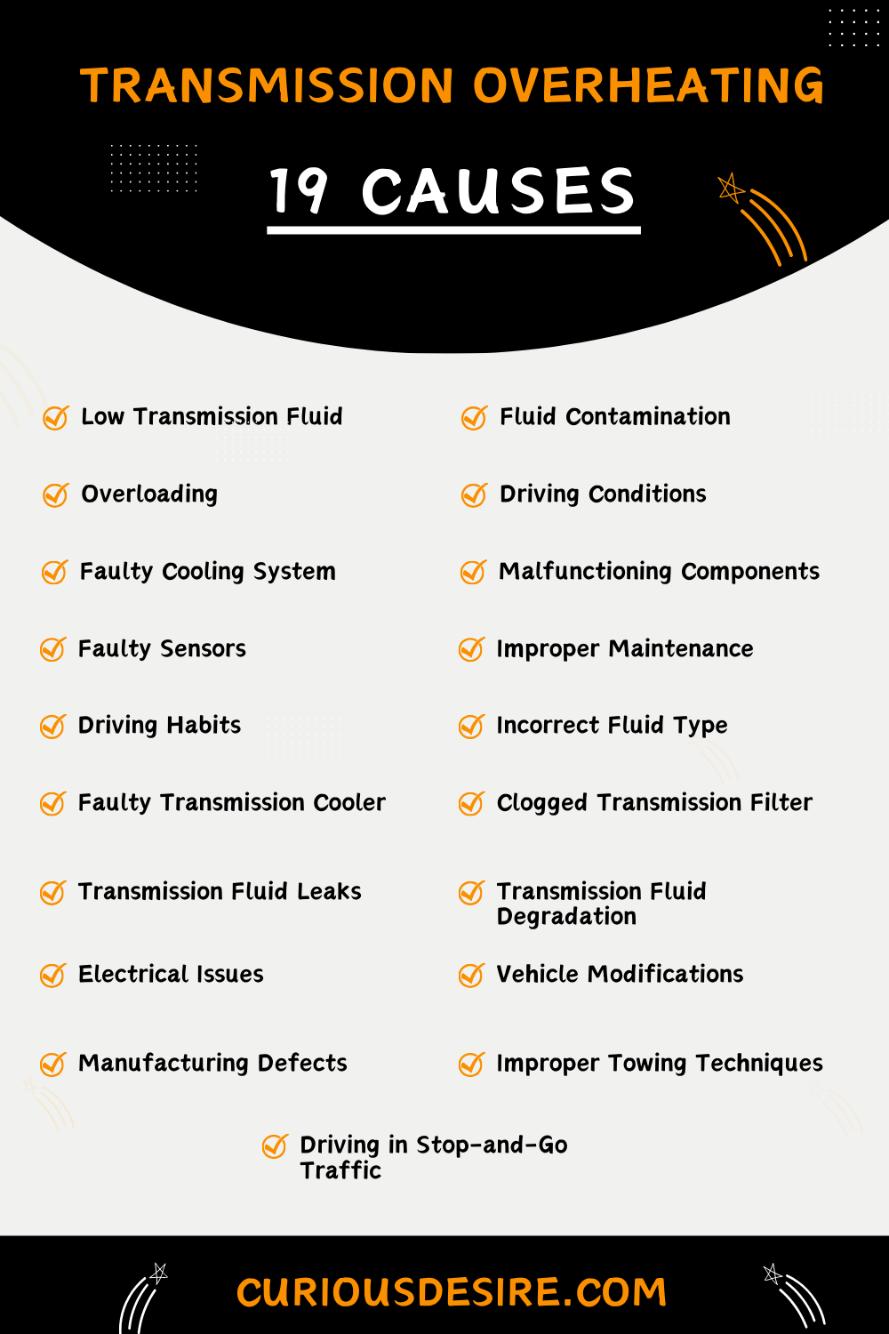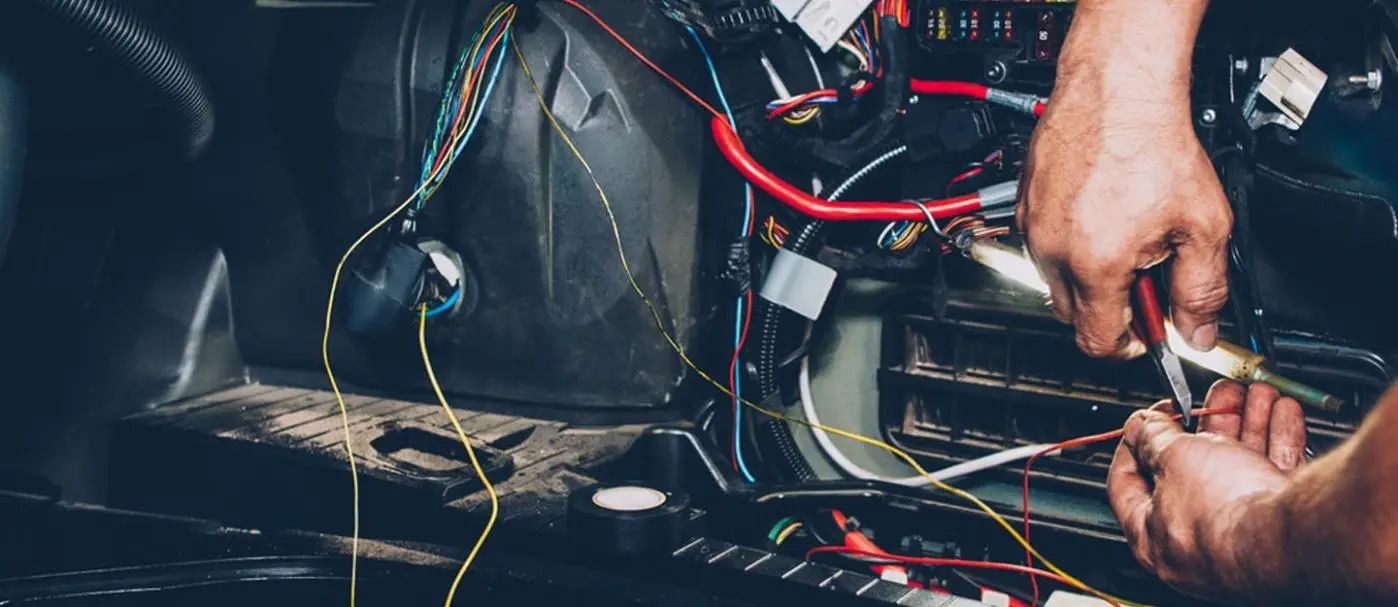Transmission overheating poses a significant risk to a vehicle’s performance and durability.
Identifying the causes of this issue is essential for maintaining the health of your transmission.
From low fluid levels to extreme driving conditions, several factors can contribute to overheating.
In this guide, we’ll explore these causes and provide practical tips to prevent transmission overheating and ensure optimal vehicle operation.
Here are the top 5 causes of transmission overheating:
- Fluid Contamination
- Low Transmission Fluid
- Faulty Sensors
- Electrical Issues
- Driving in Stop-and-Go Traffic
[toc]

Cause 1: Low Transmission Fluid
When your vehicle’s transmission fluid levels are low, it means there’s not enough of this vital fluid to lubricate and cool the transmission system properly.
This lubrication is crucial because it helps reduce friction between the various moving parts inside the transmission.
Additionally, transmission fluid also serves as a coolant, helping to dissipate heat generated by the friction and heat produced during operation.
Without enough fluid, these essential functions are compromised, leading to increased friction and heat buildup, ultimately resulting in overheating.
Regularly checking and maintaining proper transmission fluid levels is essential to prevent this issue.
Cause 2: Fluid Contamination
Contaminated transmission fluid is another common cause of overheating. Contamination can occur due to various reasons, such as the intrusion of dirt, debris, or even coolant leakage into the transmission fluid.
When the fluid becomes contaminated, its ability to effectively lubricate and cool the transmission components is compromised.
Dirt and debris can create abrasive particles that increase friction, while coolant leakage can alter the fluid’s properties, reducing its effectiveness in heat dissipation.
Cause 3: Overloading
Exceeding your vehicle’s towing or hauling capacity can put excessive strain on the transmission, causing overheating.
When you tow or haul heavy loads beyond what your vehicle is designed for, the transmission is forced to work harder to handle the increased weight.
This extra workload can generate excessive heat within the transmission system, especially during prolonged towing or hauling sessions.
To avoid overheating due to overloading, it’s crucial to adhere to your vehicle’s recommended towing and hauling limits and avoid pushing beyond its capabilities.
Cause 4: Driving Conditions
Extreme driving conditions, such as towing heavy loads uphill or driving in hot climates, can also contribute to transmission overheating.
In challenging environments, the transmission is subjected to higher levels of stress and heat buildup due to the increased workload and ambient temperatures.
Uphill driving requires the transmission to work harder to maintain momentum, while hot climates can further strain the cooling system’s ability to dissipate heat effectively.
Being mindful of these conditions and taking appropriate precautions, such as using lower gears when towing uphill or ensuring proper vehicle cooling, can help mitigate the risk of overheating.
Cause 5: Faulty Cooling System
Problems with the transmission cooler, such as blockages or leaks, can hinder the proper cooling of transmission fluid, leading to overheating.
The transmission cooler is responsible for dissipating heat from the fluid as it circulates through the system.
Blockages or leaks in the cooler can restrict the flow of coolant, reducing its effectiveness in cooling the transmission fluid.
Regular maintenance and inspection of the cooling system, including the transmission cooler, can help prevent such issues.
Cause 6: Malfunctioning Components
Issues with transmission components like the torque converter, solenoids, or clutch packs can cause friction and generate excessive heat within the transmission system.
These components play vital roles in transferring power and shifting gears within the transmission.
When they malfunction or experience excessive wear, they can create frictional heat that contributes to overheating.
Regular servicing and prompt replacement of worn or faulty components can help prevent this issue and ensure smooth transmission operation.
Cause 7: Faulty Sensors
Malfunctioning temperature sensors or control modules may fail to regulate the transmission’s temperature effectively.
Temperature sensors are responsible for monitoring the transmission fluid’s temperature and signaling the control module to adjust various parameters to maintain optimal operating conditions.
When these sensors malfunction or provide inaccurate readings, the control module may fail to activate cooling mechanisms or make necessary adjustments, resulting in overheating.
Cause 8: Improper Maintenance
Neglecting regular transmission fluid changes, filter replacements, or inspections can allow problems to go unnoticed and escalate into overheating issues.
Regular maintenance is essential for ensuring the proper functioning of the transmission system.
Failure to change the transmission fluid at recommended intervals can lead to fluid degradation and reduced cooling efficiency.
Similarly, a clogged or dirty transmission filter can impede fluid flow and cooling, increasing the risk of overheating.
Cause 9: Driving Habits
Aggressive driving behaviors, such as frequent acceleration or sudden braking, can increase the workload on the transmission and contribute to overheating.
When you drive aggressively, the transmission is subjected to rapid shifts in power and increased stress, leading to higher levels of friction and heat generation.
Additionally, excessive idling or prolonged periods of high-speed driving can also strain the transmission and contribute to overheating.
Practicing smooth and moderate driving habits can help reduce the risk of transmission overheating and prolong its lifespan.
Cause 10: Incorrect Fluid Type
Using the wrong type or grade of transmission fluid can compromise its ability to lubricate and cool the transmission system effectively, leading to overheating.
Different vehicles require specific types of transmission fluid that meet manufacturer specifications.
Using an incorrect fluid type or grade can result in poor lubrication, reduced cooling efficiency, and increased friction within the transmission.
This can ultimately lead to overheating and potential damage to transmission components.
Cause 11: Faulty Transmission Cooler
A malfunctioning or inefficient transmission cooler can fail to dissipate heat from the transmission fluid effectively.
The transmission cooler is a crucial component responsible for cooling the transmission fluid as it circulates through the system.
If the cooler is not functioning correctly due to blockages, leaks, or other issues, it can impede the cooling process, causing the transmission fluid to retain more heat.
Cause 12: Clogged Transmission Filter
A clogged or dirty transmission filter can restrict the flow of fluid, leading to reduced cooling and lubrication efficiency, which can result in overheating.
The transmission filter plays a crucial role in removing contaminants and debris from the transmission fluid to prevent them from circulating through the system.
Over time, the filter can become clogged with debris, inhibiting fluid flow and impeding the cooling and lubrication processes.
Cause 13: Transmission Fluid Leaks
Leaks in the transmission system can lead to a loss of fluid, reducing the overall volume available for cooling and lubrication, and ultimately causing overheating.
The transmission relies on a continuous supply of fluid to lubricate moving parts, dissipate heat, and facilitate gear shifts.
If there is a leak in the system, transmission fluid may escape, lowering the fluid level and compromising its ability to cool and lubricate the transmission components effectively.
Cause 14: Transmission Fluid Degradation
Over time, transmission fluid can break down and lose its viscosity and cooling properties, contributing to overheating if not replaced at recommended intervals.
Transmission fluid is subjected to high temperatures and mechanical stress during operation, causing it to degrade over time.
As the fluid breaks down, its lubricating and cooling properties diminish, leading to increased friction and heat buildup within the transmission system.
Additionally, degraded fluid may contain contaminants and debris that further inhibit its ability to effectively lubricate and cool transmission components.
Regularly changing the transmission fluid at the recommended intervals specified by the manufacturer is essential for maintaining optimal fluid quality and preventing overheating.
Cause 15: Electrical Issues
Electrical problems, such as a faulty transmission control module or wiring issues, can disrupt the transmission’s normal operation.
The transmission control module (TCM) is responsible for controlling various functions of the transmission, including shifting gears and regulating fluid pressure.
If there is a malfunction or wiring issue with the TCM, it may fail to operate the transmission components correctly, leading to erratic shifting patterns or excessive friction.
These issues can increase heat generation within the transmission system, ultimately leading to overheating.
Regular diagnostic checks and maintenance of the electrical system, including the TCM and wiring harnesses, are essential for preventing overheating due to electrical issues.
Cause 16: Vehicle Modifications
Aftermarket modifications, such as performance upgrades or alterations to the transmission system, can increase stress on components and lead to overheating if not properly designed and installed.
Modifying the vehicle’s transmission system, such as installing a higher-performance torque converter or altering gear ratios, can increase the workload on transmission components.
If these modifications are not properly designed or installed, they can cause excessive friction and heat generation within the transmission system, leading to overheating.
It’s essential to consult with a qualified professional and ensure that any modifications are compatible with the vehicle’s transmission system to prevent overheating and potential damage.
Cause 17: Manufacturing Defects
Rarely, manufacturing defects in transmission components or assembly errors can lead to premature wear or malfunction, resulting in overheating.
While modern manufacturing processes strive for high quality and precision, occasional defects or errors can occur during production.
These defects may compromise the integrity of transmission components, leading to increased friction, heat buildup, and potential overheating.
While manufacturing defects are relatively rare, they can still occur and may require inspection and replacement of affected components to prevent overheating and ensure proper transmission operation.
Cause 18: Improper Towing Techniques
Incorrect towing techniques, such as not using the appropriate gear or exceeding towing capacity, can strain the transmission and lead to overheating.
Towing heavy loads requires the transmission to work harder to maintain momentum and handle the increased weight.
If improper towing techniques are used, such as towing in the wrong gear or exceeding the vehicle’s towing capacity, the transmission may become overloaded, leading to excessive friction and heat generation.
This can result in overheating and potential damage to the transmission components.
It’s essential to follow proper towing procedures, including using the correct gear and staying within the vehicle’s towing capacity, to prevent overheating and ensure safe towing operations.
Cause 19: Driving in Stop-and-Go Traffic
Prolonged periods of stop-and-go driving, such as in heavy traffic or during city commutes, can increase transmission temperature due to constant shifting and minimal airflow for cooling.
In stop-and-go traffic situations, the transmission is subjected to frequent shifting between gears as the vehicle accelerates and decelerates.
This constant shifting increases friction and heat generation within the transmission system.
Additionally, the lack of consistent airflow at lower speeds reduces the cooling effect on the transmission fluid, further contributing to heat buildup
Transmission Overheating Causes – FAQs
1. What is the main cause of transmission overheating?
The main cause of transmission overheating is often low transmission fluid levels.
When the fluid is insufficient, it cannot properly lubricate and cool the transmission components, leading to increased friction and heat buildup.
2. How do you stop a transmission from overheating?
To prevent transmission overheating, it’s essential to maintain proper transmission fluid levels and adhere to regular maintenance schedules.
Additionally, avoid overloading the vehicle, driving aggressively, or towing heavy loads beyond its capacity.
Ensuring the cooling system, including the transmission cooler, is functioning correctly, and driving in a manner that minimizes stress on the transmission can also help prevent overheating.
3. Can low coolant cause transmission to overheat?
While low coolant levels primarily affect the engine’s cooling system, some vehicles use a transmission cooler that relies on the engine coolant to help regulate transmission temperature.
In such cases, low coolant levels could indirectly contribute to transmission overheating by impairing the cooling capacity of the transmission cooler.
4. What cools your transmission?
Transmission fluid primarily cools the transmission by transferring heat away from the components as it circulates through the system.
Additionally, vehicles equipped with automatic transmissions may have a transmission cooler, which uses air or engine coolant to dissipate heat from the transmission fluid.
5. What controls transmission temperature?
Transmission temperature is primarily controlled by the vehicle’s cooling system, including the transmission cooler.
The transmission control module (TCM) may also monitor transmission temperature and make adjustments to various parameters, such as shifting patterns or torque converter lockup, to help manage heat generation.
6. How can I improve my transmission?
To improve transmission performance and longevity, adhere to regular maintenance schedules, including fluid changes and filter replacements.
Additionally, avoid aggressive driving behaviors, overloading the vehicle, and towing beyond its capacity. Installing aftermarket transmission coolers or upgrading transmission components may also enhance performance and cooling capacity.
7. How is an automatic transmission cooled?
Automatic transmissions are typically cooled using a transmission cooler, which is either integrated into the vehicle’s radiator or mounted externally.
The transmission cooler helps dissipate heat from the transmission fluid using airflow or engine coolant, depending on the design.
8. Does coolant cool down transmission?
In some vehicles, the transmission cooler may use engine coolant to help regulate transmission temperature.
The coolant absorbs heat from the transmission fluid as it passes through the cooler, helping to dissipate heat and maintain optimal operating temperatures.
9. Does the AC cool the transmission?
The air conditioning system does not directly cool the transmission.
However, running the AC can indirectly help cool the transmission by reducing engine load and heat generation, which can benefit the overall cooling system’s performance.
10. Does idling cool a transmission?
Idling alone may not significantly cool the transmission, as it relies on airflow or coolant circulation to dissipate heat effectively.
However, idling may allow the transmission to cool down slightly if the vehicle has been subjected to high loads or operating temperatures.


